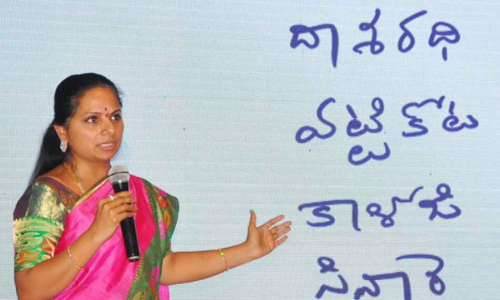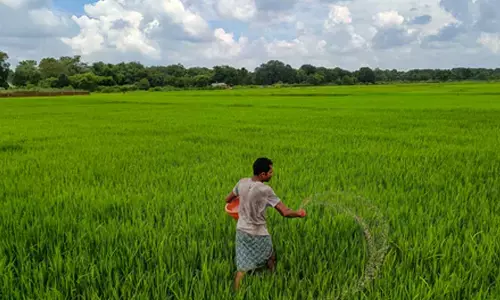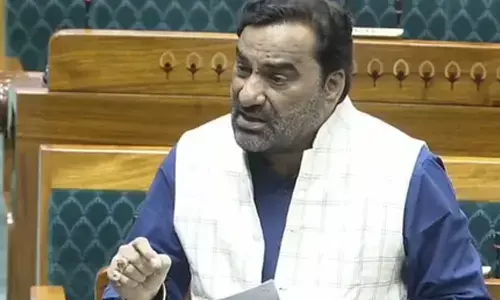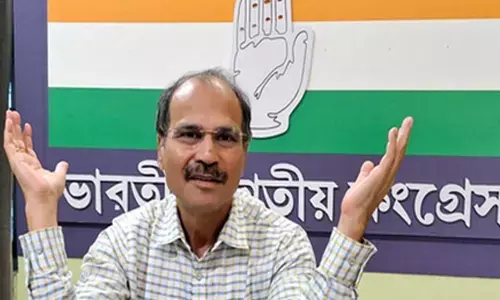Telugu Non-Resident Indians praised for their love for Telugu

TRS MP and president of Telangana Jagruthi praised the Telugu Non-Resident Indians (T-NRIs) for their love towards Telugu language and their efforts in preserving and protecting it.
Hyderabad: TRS MP and president of Telangana Jagruthi praised the Telugu Non-Resident Indians (T-NRIs) for their love towards Telugu language and their efforts in preserving and protecting it. Attending as a chief guest to a session held on T-NRIs language, culture and educational issues held at Ravindra Bharathi on Tuesday, the TRS MP has made a spectacular presentation that lasted for 30 minutes, giving an idea of the classical roots of Telugu and the journey of the language and literature native to Telangana.
Terming that the Telangana literary tradition has a rich past, Kavitha has taken a broad canvas of timeline from 3 BC to 300 AD. She asked the people to create awareness about the greatness of Telugu and the key role played by the Telangana poets and writers from the ancient times.
Asking people to bear with her handwriting in Telugu, the Telangana Jagruthi president has started her presentation with the Kotilingala coinage dating back to 3 Century BC to lend archeological credence to her presentation.
Then, the MP had said that during 2 Century BC, under the Kuntala Satakarini rule, how a Sanskrit scholar Sarva Verma and Gunadya has contributed to the poetry and termed the Gunaadya as the Adikavi for the poetic literary tradition in the world. Similarly, the Bruhathkadha had come up during the same time written in Pysachika language, she added.
It was against this backdrop that the TRS MP had stepped up her presentation giving how the “Vemulavada Sahitya Yugam’ (The epoch of Vemulawada literary tradition) has started.
She claimed that the court language then was Prakrithi, Sanskrit, and Kannada. And, the Adi Kavi of Kannada had written Adi Purana in that language and Jinendra Purana in the Telugu language. This was further getting established with the Kurikyala inscription in 945 AD of Jeena Vallbha's, in which “we find a Kanda Padyam (written in Kanda meter of Telugu poetry)”, she added.
Further, at about 935 Century AD, writing, ‘Kavi Janasrayam’ by Yalliya Rechana had come up during the period. It was about 100 years prior to Nannayya, who had started the Andhra Mahabharata, that Kavya literature has begun in Telangana, she said.
Similarly, there are several other firsts like Baddena’s "Neeti Sastra Mukthavali (Sumathi Satakami) native to Telangana, and poet Bhima from the state had been considered as the Adi Kavi or the first poet of Telugu, even during the days of another famous poet Srinadha during 14th Century AD, she noted.
Drawing how different kings starting from Satavahana's down to the days of the Asaf Jahi dynasty till the country has become a modern independent democratic nation, Kavitha had made a detailed presentation of how different languages like Prakrithi, Sanskrit, Kannada, and Telugu were used as the court languages by different kings.
It was during the Kakatiya rule in 1052 -1323 century AD that Sanskrit and Telugu had become the two of the court languages, she said. While “we find the Telugu words in King Hala’s Gadha Sapatha Sathi (in Prakruthi) way back in 1 Century BC, It was the Palkuriku Somanadha who had first used the Telugu word. Thus, he qualifies to be called as the Adikavi, she said.
Likewise, Kavitha went on to explain to the audience how poets like Krishnamacharyulu, Gona Buddha Reddy, poet Marana, besides, Jeyapa Senanai writing the first dance manual of Perini Sivathandavam were among the several firsts with which the state had contributed to the Telugu language and literary world, she said.

















